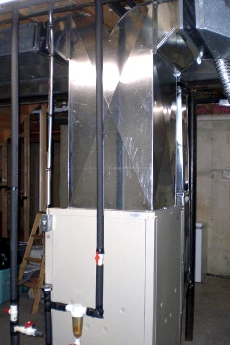
We can help you design or evaluate your air ducting for use with a geothermal heat pump, whether you are building a new home, or replacing your existing fossil fuel furnace. Most forced air ducting systems are designed to be used with fossil fuel furnaces, which output air at about 130-160°F. A water-to-air geothermal heat pump outputs air at about 95-100°F, meaning it is more efficient, but requires more airflow for proper operation. Your air ducting must be able to provide this higher airflow, efficiently, and without being noisy. Additionally, the duct design should allow the proper amount of air to reach each area of your home.
 The total air flow through the geothermal heat pump and ducting must be at the geothermal manufacturer's rated CFM (cubic feet per minute), and at the rated static pressure. If the air ducting is too small, the air will move too slowly, causing inefficient geothermal operation. Simply increasing blower speed will not solve the problem, since the extra blower energy use will lower the system's efficiency. The only way to get the correct amount of air flow, with acceptable energy use, is to have large enough air ducting.
The total air flow through the geothermal heat pump and ducting must be at the geothermal manufacturer's rated CFM (cubic feet per minute), and at the rated static pressure. If the air ducting is too small, the air will move too slowly, causing inefficient geothermal operation. Simply increasing blower speed will not solve the problem, since the extra blower energy use will lower the system's efficiency. The only way to get the correct amount of air flow, with acceptable energy use, is to have large enough air ducting.
The air ducting system should also be quiet. The blower noise, or any noise that the geothermal heat pump makes, must not travel through the air ducting system. Using vibration dampers on the supply and return air ducts or plenums, and lining these areas for 5 feet in each direction with an approved sound deadening material, will usually prevent this. Also, room air registers should be sized large enough to let the air flow quietly through them. You shouldn't be able to hear your geothermal heat pump running; you should only know it is operating by the very gentle movements of your curtains.
Finally, the air ducting must provide the correct air flow to each room. Air flow is affected by the air pressure in the ducting, which is determined by the length and size of the duct, and the speed of the blower motor. Every room should have a return air register, or else air flow will be interrupted when the room's door is shut. There are some methods allowed to compensate for lack of returns, such as undercutting doors, or overhead jumpers, but the best aesthetics and performance will come from having returns in each room.
Duct Design includes the following:
If you will be building a new home and are using professional duct installers, you can have them size and design your ducting system. If you would like us to design your ducts, let us know and we can give you a price based on the square footage and complexity of the system. For ducts installed all on a single floor, either basement or attic space, duct design is usually $550.00 USD for a single zone system.
For the best control of room air flow, an automatic duct damper system should be used. Automatic duct dampers open or close air ducts as a zone's air flow requirements change, according to the zone's thermostat. They allow that zone to be kept a few degrees warmer or cooler than the main system setting, if you prefer it. For example, some people like to keep their master suite cooler than the rest of the home, while they sleep at night. Duct dampers also automatically adjust for the effects of the sun shining on one side of the home, or different amounts of air infiltration from the wind, so that each zone stays at the desired temperature. You can usually have up to three ducts zones per geothermal unit, with each zone being no less than 25% of your home's load. A zoned duct system design will cost $825.00 USD, and will include wiring and control schematics for the zoning, and links to online sources for the controls and dampers.